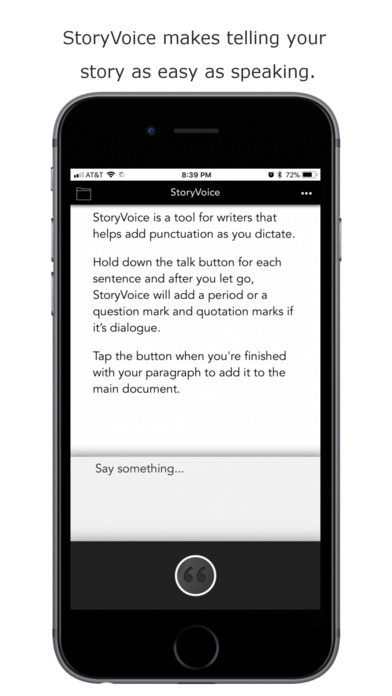
Created by best-selling author and Thriller Award finalist, Andrew Mayne (Angel Killer, The Naturalist and Station Breaker), StoryVoice is a tool for writers designed to make it easier to dictate stories and write flowing dialogue. StoryVoice automatically adds punctuation and quotation marks to spoken sentences and allows you to focus on creating.
Check out the tutorial video at StoryVoiceApp.com
1.) Press and hold the talk button down to add one sentence at a time to the paragraph builder.
2.) Release the button after each sentence is finished.
3.) When youve finished adding sentences to your paragraph, press and release the talk button to add your paragraph to the main document.
StoryVoice automatically tries to figure out if a sentence is a statement or a question and add the appropriate punctuation.
StoryVoice will try to interpret dialogue by looking for phrases like "Stephanie said" or "he replied" in a sentence or paragraph and add quotation marks and punctuation.
If you want to insert a comma, say "comma" as you dictate.
To redo the last sentence, say "Redo that."
To remove the last paragraph, say "Remove the last paragraph."
StoryVoice is designed for writers to make it easier to dictate stories without having to worry about pronouncing punctuation like quotation marks, periods and question marks. It’s intended to be a more natural way to dictate. With regular dictation, to write something like this:
“Where do we go from here?” Amanda asked.
You have to say it like this:
Quote Where do we go from here question mark end quote Amanda asked period
Traditional dictation requires seven extra words and more than twice as many syllables than the original sentence – requiring you to talk twice as much as the original sentence.
To write the same sentence in StoryVoice, you just say:
Where do we go from here Amanda asked
StoryVoice figures out that Amanda is the speaker and that she’s asking a question. It then automatically adds in the appropriate quotation marks and punctuation for the end of the sentence and wraps the paragraph with quotation marks in the right places if it’s more than one sentence.
How does StoryVoice work?
StoryVoice uses a combination of special patterns related to written text and Natural Language Processing to try to tell if a sentence or paragraph is dialog, a statement or a question.
StoryVoice tries to spot names and pronouns along with verbs and adverbs associated with dialog and questions. It picks up on phrases like “Rebecca replied” or “Ken said excitedly.” More complex structure can be difficult to parse, so StoryVoice defaults to the standards used in popular fiction.


